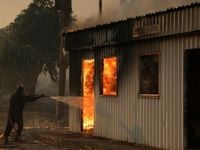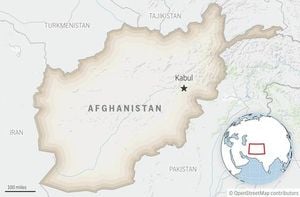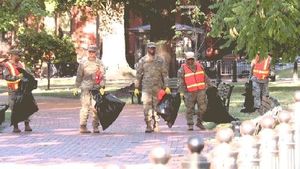Southern Europe is once again facing the devastating wrath of wildfires, as blazes intensified across multiple countries on August 13, 2025, leaving a trail of destruction, displacement, and loss. From Greece’s western shores to the hills of Montenegro, firefighters, volunteers, and local residents have been locked in a relentless struggle against flames fueled by weeks of scorching heat, strong winds, and bone-dry conditions. The human toll and environmental impact are mounting, with at least three confirmed deaths and thousands forced to flee their homes.
Greece, in particular, has endured what officials are calling the hardest days yet of this year’s wildfire season. According to Fire Service spokesman Vassilis Vathrakoyiannis, the country recorded 82 new fires in a single day, a number he described as “exceptionally high.” The situation was especially dire near the port city of Patras, Greece’s third-largest city, where two massive fires raged on the hard-hit Peloponnese peninsula. “Today is another very difficult day with the level of fire risk remaining very high across many parts of the country,” Vathrakoyiannis warned, as reported by the Associated Press.
The flames tore through pine forests and olive groves, threatening homes and agricultural facilities. Tall columns of fire rose ominously behind apartment blocks on Patras’s outskirts, and dozens of vehicles were reduced to charred shells in a nearby impound lot. Residents, undeterred by the danger, joined firefighters in the battle, wielding cut branches or buckets of water in a desperate attempt to stave off the advancing inferno. Water-dropping planes and helicopters swooped overhead, providing crucial support as nearly 5,000 firefighters and 33 aircraft were deployed across affected regions, including the tourist islands of Chios and Zakynthos.
The strain on resources was palpable. Firefighters on Chios were so exhausted after night-long shifts that they slept on the roadside. Aircraft rotated constantly between blazes on the western mainland, Patras, and the islands, as new evacuation orders forced thousands to abandon their homes. On August 12, some 7,700 people near Patras were ordered to evacuate, and by the following day, several more villages received similar directives. The coastguard had to rescue dozens from Limnia harbor on Chios, where smoke had grown so thick it blotted out the sun. Thirteen firefighters were treated for burns and other injuries, and at least 15 were hospitalized for burns, smoke inhalation, or exhaustion, according to multiple news outlets including Al Jazeera and the Associated Press.
Greece’s call for help did not go unanswered. The country requested additional firefighting aircraft from fellow European Union members through the EU Civil Protection Mechanism. Athens also sent aid to neighboring Albania, joining an international effort to quell dozens of wildfires raging across the Balkans.
The tragedy was not confined to Greece. In Albania, an 80-year-old man died from smoke inhalation after a blaze he lit in his yard spiraled out of control, spreading to nearby villages in the Gramsh area. Four villages in central Albania near a former army ammunition depot were evacuated, and in the southern Korca district, explosions echoed from buried World War II-era artillery shells. Dozens of homes were gutted, and the devastation prompted authorities to warn of further dangers. In Montenegro, a soldier lost his life and another was seriously injured when their water tanker overturned while battling wildfires near the capital, Podgorica. Ljuban Tmusic, head of Montenegro’s civil protection agency, summed up the dire situation: “Natural disasters know no borders. In Montenegro, the resources we have ... are clearly not enough.”
Spain, too, was gripped by tragedy. In the Castile and León region north of Madrid, a firefighting volunteer died, and thousands were displaced as evacuation centers filled to capacity. Some evacuees spent the night outdoors on folding beds, while others hosed down the walls of their homes in a last-ditch effort to keep the flames at bay. The Spanish government raised its national emergency response level, and Prime Minister Pedro Sánchez expressed his condolences, stating, “The wildfire situation remains serious, and taking extra precautions is essential. Thank you, once again, to all those working tirelessly to fight the flames.” An employee of a Spanish equestrian center died from his injuries in Tres Cantos, a suburb north of Madrid, while another man was killed fighting fires in Castile and León. About 2,000 people were evacuated from hotels and homes near the beaches of Tarifa in Andalusia, and dozens of blazes threatened Las Medulas, a UNESCO World Heritage site.
Elsewhere in Europe, the crisis deepened. In Turkey, a forestry worker died in a fire truck accident while responding to wildfires in the south, with four others injured. The country has been battling severe blazes since late June, with a total of 18 deaths, including 10 rescue volunteers and forestry workers in July alone. France, still recovering from recent massive fires in its southern regions, braced for a third consecutive day of temperatures reaching up to 42 degrees Celsius (108 Fahrenheit). Weather alerts allowed local authorities to cancel public events and cordon off high-risk areas. Southern France broke temperature records at four weather stations, and three-quarters of the country was under heat alerts.
Italy was not spared either. Eleven major cities, including Rome, Milan, and Florence, were placed on red alert due to the heat, and a child died of heatstroke. In Portugal, firefighters battled three large wildfires, with the most serious near Trancoso in the center of the country. Across the continent, heat alerts were issued in Italy, France, Spain, Portugal, and the Balkans, with forecasts predicting temperatures above 40 degrees Celsius (104 Fahrenheit) in some regions. According to the EU climate monitor Copernicus, smoke and greenhouse gas emissions from these forest fires are among the highest ever recorded in the Northern Hemisphere since the beginning of summer.
Authorities have cited a range of causes for these devastating fires, including careless farming practices, improperly maintained power cables, and summer lightning storms. Law enforcement in North Macedonia pointed to indications of arson, allegedly motivated by rogue developers, as firefighters struggled to contain a blaze at a nature reserve outside Skopje. The European Union responded by rushing aid to both member and non-member states, sending ground crews and water-dropping aircraft to the hardest-hit areas, with a particular focus on Montenegro.
As southern Europe battles the flames, the resilience and solidarity of its people are on full display. Volunteers, professional firefighters, and everyday citizens are working side by side, often at great personal risk, to save their communities and cherished landscapes. The scale of the disaster is sobering, and the road to recovery will be long and challenging. But for now, the fight continues—against the fires, the heat, and the ever-present threat of disaster.




